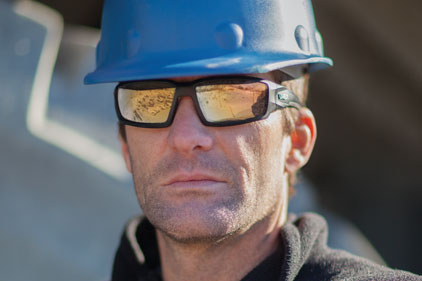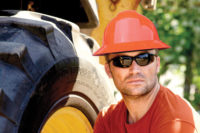Today, there are more options than ever for protecting workers’ vision in multi-hazard environments. From specialized lens tints and advanced lens coatings to hybrid eyewear styles, there is a solution to meet the needs of nearly every unique combination of hazards. This article discusses key considerations for delivering effective safety eyewear to workers in hazardous occupations who also face demanding summer conditions.
Oil & gas
Individuals working in oil and gas commonly work long shifts at drilling sites, refineries and chemical plants. In the summer, this means intense, prolonged exposure to sunlight and extreme temperatures in extremely dry or humid, windy, dusty and dirty environments. Selecting eyewear that protects from dust, grime, chemicals and sweat is a must. Furthermore, since getting struck by equipment is a leading cause of injury and fatality in the field, providing eyewear that delivers a wide unobstructed view and a distraction-free fit is imperative.
Protecting from all these various hazards is a tall order for traditional safety spectacles. A more effective solution is high performance sealed eyewear. A recent addition to protective eyewear offerings, sealed eyewear is a hybrid style that offers the sleek, low-profile comfort of safety eyewear with the added fit and all-around protection of a goggle. Look for a style whose lens allows for unobstructed peripheral vision to reduce the risk of getting struck. Next, look for a style that ensures comfort and fit. A secure seal between the wearer’s skin and eyewear is required to block out fine particulate contamination, and properly utilizing the strap ensures that sealed eyewear fits snugly against the face for full effectiveness. Selecting snug, well-fitting eyewear also eliminates hazardous distractions caused by slipping or uncomfortable eyewear.
Another common hazard is humidity, an environmental force that causes lenses to fog and visibility to obscure. Fogging is also caused by rapid changes in temperature, such as when workers transition from inside an air conditioned vehicle to a hot and humid outdoor environment, as well as by the rise in body temperature resulting from exertion. In order to gain a clear view, workers either remove foggy eyewear to wipe it clean or leave it off altogether, leaving themselves vulnerable to injury.
To combat fog, look for advanced anti-fog coatings with combined hydrophilic and hydrophobic properties that promote a clear view even in the most extreme environments. Anti-fog wipes are another good solution for on-the-spot removal of fog and extended anti-fog properties. Finally, look for eyewear styles with ventilation designed into the frame which promotes airflow and reduces the potential for fogging.
Utilities
Utilities are another high-hazard industry in which workers face a variety of occupational and environmental eye hazards. The most common occupational hazard is accidental exposure to arc flash: intense visible light as well as ultraviolet (UV) and infrared (IR) radiation produced by the arc that can cause temporary or even permanent eye damage or blindness. Safety managers should protect utility workers by providing lens tints specifically designed to minimize the effects of arc flash exposure. While many utility-rated tints exist, be sure to select from those that permit true color recognition, allowing workers to easily distinguish wire colors and other fine detail.
Outdoor conditions can pose additional hazards to utility workers’ eyes. Most of the U.S. relies on coal-powered generators for electricity, and movement of materials in these production facilities results in coal dust contamination. Sealed eyewear is a preferred solution for workers who work in near proximity to the coal fuel.
Since coal plants rely on outdoor fuel storage, workers are also commonly subjected to varying light conditions. When transitioning from low indoor light to bright sunlight, the eyes can take up to several minutes to adjust, leaving workers at risk. One solution is to outfit workers with two pairs of safety eyewear — one with clear lenses for indoor use and one tinted for outdoors. The optimal solution, however, is a fast-acting and wide-range photochromic eyewear option, whose built-in technology quickly adjusts the lens shade according to brightness. Since nearly all utility line work is performed outside or underground, anti-fog and photochromic lenses are also extremely valuable to worker safety.
Construction
Construction workers often perform various job functions in a day, from carpentry and mixing concrete to welding and pipe fitting. Related eye hazards range from exposure to flying objects, chemicals or harmful radiation to a combination of these, and injuries can result in temporary or permanent blindness and even the loss of an eye. Summer conditions pose additional visible and invisible risks to construction workers’ eyes, including UV, bright light, glare and humidity.
Safety managers should select the style of protective eyewear (i.e. spectacles, goggles or sealed eyewear) based on the hazards present. In outdoor conditions, however, special attention should be paid to protecting the eyes from environmental hazards as well. Intense exposure to the sun’s invisible ultraviolet light can lead to photokeratitis, a short-term corneal injury, and long-term exposure commonly leads to cataracts. Employees who spend any time outside should be outfitted with eyewear that blocks UV and whose lenses are marked with a corresponding “U.” Visibly bright sunlight also presents hazards, and overexposure can result in headaches as well as eye fatigue, redness, dryness and irritation. To combat natural light hazards, eyewear with standard gray, brown or mirrored lens tints offer suitable protection and may be selected based on user preference.
Glare is another common hazard that occurs when light is reflected off water, sand, snow, glass, sheet metal or concrete. Intense reflected or scattered light causes pupils to constrict and impairs vision. To combat glare, eyewear should be mirrored, polarized or darkly tinted, preferably in wraparound-style frames to cover all angles. Appropriate lenses should be marked with an “L.” Finally, like in oil and gas and utility applications, fogging is a major concern. Be sure to select lenses with advanced anti-fog coatings and frames designed with ventilation to promote a long-lasting, clear view.
When work is conducted outdoors, environmental conditions lead to increased eye hazards. By selecting well-fitting and comfortable eyewear that also combats the effects of heat, humidity, and bright and invisible light, safety managers encourage all-day wear, helping workers avoid injury and prolong eye health.


